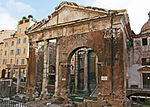Raid on the Roman Ghetto
1943 crimes in ItalyHolocaust massacres and pogroms in ItalyJewish Roman (city) historyJewish ghettos established by Nazi GermanyNazi-Jewish negotiations ... and 3 more
October 1943 eventsRome in World War IIThe Holocaust in Italy

The raid on the Roman Ghetto took place on 16 October 1943. A total of 1,259 people, mainly members of the Jewish community—numbering 363 men, 689 women, and 207 children—were detained by the Gestapo. Of these detainees, 1,023 were identified as Jews and deported to the Auschwitz concentration camp. Of these deportees, only fifteen men and one woman survived.
Excerpt from the Wikipedia article Raid on the Roman Ghetto (License: CC BY-SA 3.0, Authors, Images).Raid on the Roman Ghetto
Via del Tempio, Rome Municipio Roma I
Geographical coordinates (GPS) Address Nearby Places Show on map
Geographical coordinates (GPS)
| Latitude | Longitude |
|---|---|
| N 41.8925 ° | E 12.4775 ° |
Address
Scuola Elementare Vittorio Polacco
Via del Tempio 5
00186 Rome, Municipio Roma I
Lazio, Italy
Open on Google Maps










